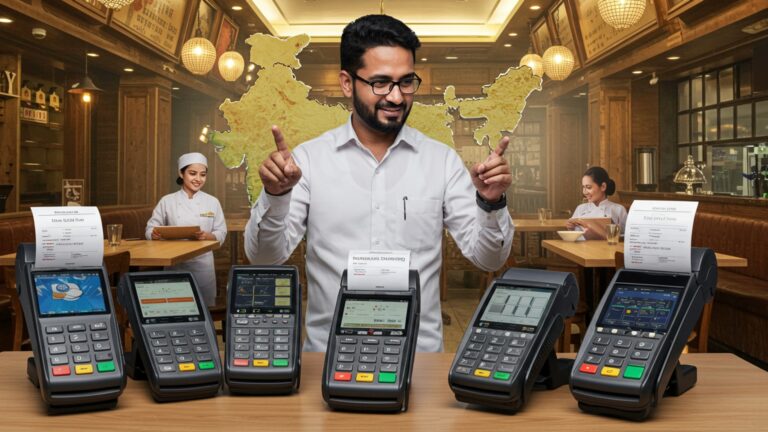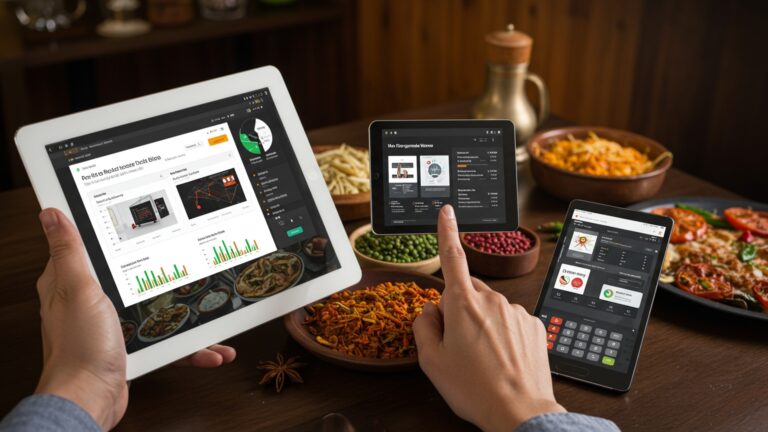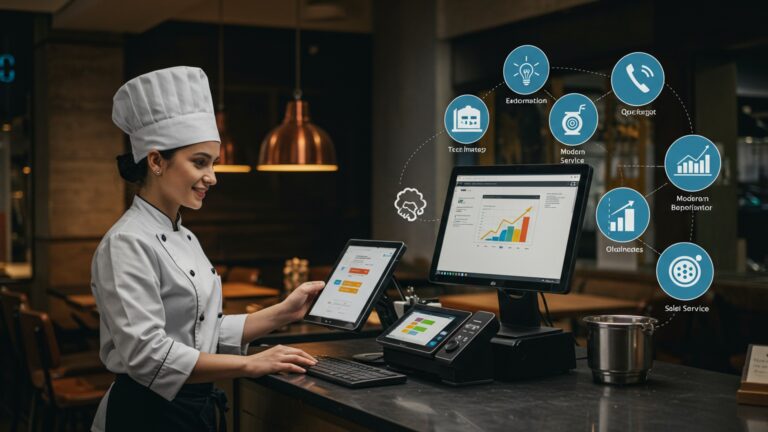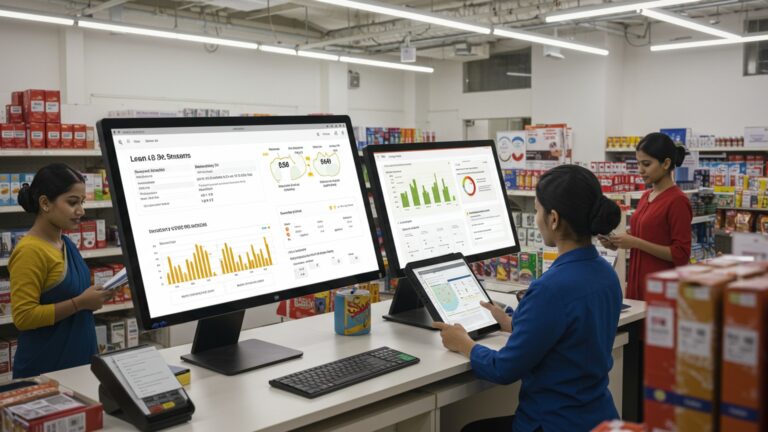How to Master Inventory Management with POS in India 5 Tips
Indian businesses, from traditional retail outlets navigating diverse regional demands to booming e-commerce platforms, constantly face the critical challenge of efficient inventory management. The volatile market and rapid consumer shifts, especially post-pandemic, amplify the financial strain of stockouts or excessive carrying costs. Mastering inventory management POS India is no longer a luxury but a strategic imperative. Modern Point-of-Sale systems transcend basic transaction processing, transforming into intelligent hubs that provide real-time stock visibility, predict demand fluctuations. automate procurement. This integration empowers retailers to minimize waste, capitalize on peak sales cycles like Diwali. maintain agile supply chains, directly boosting profitability and customer satisfaction in India’s competitive landscape.

Understanding the Core: What is Inventory Management and POS?
Effective retail operations hinge on two critical components: Inventory Management and Point of Sale (POS) systems. While often discussed separately, their seamless integration is paramount, especially for businesses navigating the dynamic Indian market. Understanding these concepts individually and then as a unified solution is the first step towards mastering your retail strategy.
What is Inventory Management?
At its heart, inventory management is the systematic process of overseeing and controlling a company’s stock – from sourcing raw materials to storing finished goods and fulfilling orders. It encompasses tracking inventory levels, orders, sales. deliveries, with the ultimate goal of minimizing the costs associated with holding inventory while ensuring products are available when customers want them. For a business in India, this could mean managing everything from textiles in a boutique to groceries in a supermarket, or electronics in a retail chain.
- Key aspects include:
- Tracking stock levels in real-time.
- Monitoring product movement (in and out).
- Optimizing storage and warehousing.
- Forecasting demand to prevent overstocking or stockouts.
- Managing returns and damaged goods.
What is a Point of Sale (POS) System?
A Point of Sale (POS) system is the place where a customer makes a payment for products or services. More than just a cash register, modern POS systems are comprehensive platforms that manage sales, process payments, track customer data, and, crucially, integrate with inventory. Think of it as the central nervous system of your retail operation. When a customer in Delhi buys a product, the POS system records the sale, processes the payment. simultaneously updates the inventory count.
- Core functionalities typically include:
- Processing sales transactions (cash, card, UPI, etc.) .
- Printing receipts.
- Managing customer loyalty programs.
- Tracking employee performance.
- Generating sales reports.
The Power of Integration: Inventory Management POS India
The real magic happens when inventory management and POS systems are integrated. This integration allows for automatic updates of stock levels every time a sale is made or a return is processed. This synergy is not just a convenience; it’s a strategic necessity for businesses in India aiming for efficiency, profitability. customer satisfaction. Without an integrated system, businesses face manual data entry errors, delayed inventory updates. a significant risk of stock discrepancies, leading to lost sales or excess holding costs. The right Inventory management POS India solution acts as a backbone for streamlined operations, crucial for both small kirana stores and large retail chains.
Tip 1: Automate Stock Tracking for Real-Time Accuracy
One of the most significant challenges in inventory management is maintaining accurate stock counts. Manual tracking methods, often relying on spreadsheets or paper ledgers, are prone to human error, time-consuming. provide outdated details. The solution lies in embracing automation through your POS system.
How POS Systems Automate Stock Tracking
An integrated POS system transforms stock tracking from a tedious manual process into an efficient, real-time operation. When a product is scanned at the checkout, the POS system automatically deducts that item from your inventory count. Similarly, when new stock arrives and is logged into the system, the inventory levels are updated instantly. This eliminates the need for manual record-keeping for every sale and purchase.
- Key automation features:
- Barcode Scanning: Products are assigned unique barcodes. Scanning them during sales or receiving stock ensures accurate and rapid data entry.
- Automatic Deductions: Each sale automatically reduces the stock count for the item sold.
- Receiving & Returns Management: POS systems allow for easy logging of incoming shipments and processing of customer returns, instantly updating inventory levels.
- Batch Processing: For businesses dealing with large quantities of similar items, POS systems can handle batch updates efficiently.
Benefits of Real-Time Automated Tracking
Automated stock tracking provides a multitude of benefits that directly impact a business’s bottom line and operational efficiency:
- Reduced Errors: Minimizes human errors associated with manual data entry, leading to highly accurate inventory records.
- Time-Saving: Frees up staff from mundane data entry tasks, allowing them to focus on sales, customer service, or other value-adding activities.
- Prevents Stockouts & Overstocking: Real-time data means you know exactly what you have on hand, preventing the frustration of telling a customer an item is out of stock, or the financial burden of holding excess inventory.
- Improved Cash Flow: By optimizing stock levels, you tie up less capital in inventory, improving cash flow for other business needs.
- Enhanced Customer Satisfaction: Accurate inventory data allows for reliable promises to customers regarding product availability, whether in-store or online.
Actionable Takeaway: Implement Barcode Systems and Train Staff
To leverage this tip effectively, ensure all your products are barcoded. Invest in a reliable barcode scanner that integrates seamlessly with your POS. Crucially, train your staff thoroughly on how to use the POS system for every transaction – sales, returns. receiving new inventory. A retail fashion boutique in Mumbai, for instance, saw a 20% reduction in stock discrepancies within three months of implementing a new Inventory management POS India system with full barcode integration and comprehensive staff training. This prevented them from losing sales on popular items that were actually in stock but miscounted.
Tip 2: Leverage Data Analytics for Smarter Forecasting
Beyond simply tracking what you have, a powerful POS system allows you to interpret why you have it, how fast it sells. what customers are really buying. This is where data analytics comes into play, transforming raw sales data into actionable insights for smarter forecasting and purchasing decisions.
Unlocking Insights from Your POS Data
Your POS system is a treasure trove of data. Every transaction, every item sold, every return. every payment method contributes to a vast dataset that can reveal critical patterns about your business. Modern POS systems come equipped with robust reporting and analytics features that go far beyond basic sales summaries.
- Key Metrics Your POS Can Reveal:
- Sales Trends: Identify peak selling times, days, weeks. months. grasp how sales fluctuate seasonally or during promotions.
- Popular Items (Best Sellers): Discover which products are flying off the shelves and which are consistently underperforming.
- Slow-Moving Stock: Pinpoint items that are tying up capital and taking up valuable shelf space.
- Seasonal Demand: Track how demand for specific products changes with festivals (e. g. , Diwali, Christmas), holidays, or local events.
- Customer Purchase History: grasp buying patterns of individual customers or customer segments.
- Vendor Performance: Evaluate which suppliers consistently deliver on time and with quality products.
How POS Analytics Aids Forecasting
By analyzing these metrics, businesses can move from reactive ordering to proactive forecasting. Instead of guessing what to order, you can make data-driven decisions that minimize waste and maximize sales.
- Optimized Ordering: Based on historical sales data and trends, you can accurately predict future demand, allowing you to order optimal quantities. This prevents both stockouts of popular items and overstocking of slow movers.
- Reduced Waste and Markdowns: For perishable goods or fashion items, accurate forecasting means less spoilage or fewer items needing heavy discounts to clear.
- Improved Cash Flow: Investing capital only in products that are likely to sell quickly and in appropriate quantities frees up cash for other business investments.
- Strategic Promotions: Identify opportunities for promotions on slow-moving items or bundle popular products with less popular ones.
- Better Supplier Negotiations: Armed with clear sales data, you can negotiate better terms, quantities. delivery schedules with your suppliers.
Actionable Takeaway: Regularly Review POS Reports and Adjust Strategy
Make it a regular practice to delve into your POS system’s analytics reports. Schedule weekly or monthly sessions to review sales performance, inventory turnover rates. identify trends. Adjust your purchasing strategies based on these insights. For example, an electronics store in Delhi, specializing in consumer gadgets, meticulously uses its Inventory management POS India system’s sales data to predict demand for new smartphone models during festival seasons. By analyzing pre-booking trends and historical sales during similar periods, they can place accurate bulk orders, ensuring they meet customer demand without holding excessive stock after the festive rush. This proactive approach has significantly reduced their carrying costs and improved their profit margins during high-volume sales periods.
Tip 3: Implement Seamless Multi-Channel Inventory Synchronization
In today’s interconnected retail landscape, many businesses in India operate across multiple sales channels – a physical storefront, an e-commerce website. perhaps even marketplaces like Amazon India or Flipkart. The challenge? Keeping inventory synchronized across all these channels to prevent overselling or underselling, which can severely damage customer trust and operational efficiency.
The Multi-Channel Inventory Challenge
Imagine a customer buying a product online that you just sold in your physical store, or vice-versa. This leads to order cancellations, customer disappointment. negative reviews. Manual synchronization across multiple platforms is not only labor-intensive but also highly prone to errors and delays, making real-time accuracy virtually impossible.
How POS Integrates for Multi-Channel Synchronization
A robust POS system acts as the central hub for your inventory, regardless of where the sale originates. When integrated correctly, it ensures that your stock levels are updated across all your sales channels in real-time. This means:
- Unified Inventory Pool: All available stock is drawn from a single, centralized inventory database managed by your POS.
- Automatic Updates: A sale on your e-commerce site instantly deducts the item from the central inventory. this updated count is reflected across your physical store and any other integrated marketplaces. The same happens for in-store sales.
- Centralized Management: You can manage all your product listings, prices. stock levels from one dashboard within your POS system, rather than logging into multiple platforms.
- Order Management: All orders, whether from online or offline channels, can be viewed and managed from your POS, streamlining fulfillment.
Benefits of Seamless Synchronization
Achieving true multi-channel inventory synchronization offers profound advantages:
- Prevents Overselling/Underselling: The most critical benefit is eliminating the risk of selling an item you don’t have, or missing a sale because you thought you were out of stock.
- Consistent Customer Experience: Customers receive accurate details about product availability, leading to greater trust and satisfaction.
- Centralized Control: Simplifies inventory management, reducing administrative overhead and the potential for errors.
- Improved Efficiency: Streamlines order fulfillment and reduces the time spent on manual inventory adjustments.
- Scalability: Enables businesses to expand to new sales channels without overwhelming their inventory management capabilities.
Actionable Takeaway: Choose a POS System with Robust Integration Capabilities
When selecting an Inventory management POS India solution, prioritize systems that offer strong, pre-built integrations with popular e-commerce platforms (like Shopify, WooCommerce) and marketplaces (Amazon India, Flipkart). If direct integrations aren’t available, look for POS systems with open APIs that allow for custom integrations. A handicrafts seller in Bengaluru, for example, successfully manages their physical store, their own e-commerce website. their listings on platforms like Etsy and Amazon India using a single integrated POS system. When a unique piece is sold in their store, its availability is immediately updated online, preventing frustrating “out of stock” notifications for online shoppers. vice-versa. This seamless operation has allowed them to significantly expand their market reach without compromising inventory accuracy.
Tip 4: Optimize Supplier Relationships and Reorder Points
Effective inventory management isn’t just about what happens within your store; it extends to your supply chain. How you manage your relationships with suppliers and strategically set reorder points directly impacts your ability to maintain optimal stock levels, avoid disruptions. improve profitability. Your POS system can be a powerful tool in this aspect.
The Interplay of Inventory, Suppliers. Reorder Points
The flow of inventory into your business is dictated by your suppliers. Delays, inconsistent quality, or unfavorable terms from suppliers can have a ripple effect on your stock levels and customer satisfaction. Setting appropriate reorder points is crucial to ensure you never run out of popular items while also avoiding excessive inventory holding costs.
- Key Concepts:
- Lead Time: The time taken from placing an order with a supplier to receiving the goods.
- Safety Stock: Extra inventory held to guard against unforeseen demand fluctuations or supply chain delays.
- Reorder Point: The minimum level of inventory at which a new order should be placed with a supplier.
How POS Systems Assist in Supplier and Reorder Optimization
Modern POS systems offer features that streamline supplier management and automate reorder processes, turning data into procurement intelligence:
- Supplier Performance Tracking: Your POS can log delivery dates, order accuracy. even product quality issues associated with specific suppliers. This data helps you evaluate supplier reliability and negotiate better terms.
- Automated Reorder Levels: Based on historical sales data, lead times. desired safety stock, your POS can automatically calculate and suggest reorder points for each product. Some advanced systems can even trigger purchase orders automatically when stock hits the reorder level.
- Purchase Order Management: Create, send. track purchase orders directly from your POS system, simplifying the procurement process.
- Cost of Goods Sold (COGS) Tracking: Accurately track the cost of items from different suppliers, aiding in pricing strategies and profitability analysis.
Benefits of Optimized Supplier Relations and Reorder Points
Strategic management in this area yields significant operational and financial benefits:
- Avoid Stockouts: Automated reorder alerts ensure you replenish stock before popular items run out, preventing lost sales and customer frustration.
- Reduce Overstocking: Data-driven reorder points prevent you from ordering too much, reducing carrying costs, potential spoilage. obsolescence.
- Streamlined Procurement: Automating purchase orders and tracking simplifies the buying process, saving time and administrative effort.
- Improved Cash Flow: By optimizing inventory levels, capital is not unnecessarily tied up in excess stock.
- Stronger Supplier Relationships: Data on supplier performance allows for informed discussions and building stronger, more reliable partnerships.
Actionable Takeaway: Configure Minimum Stock Levels and Communicate Clearly
Utilize your Inventory management POS India system to set minimum stock levels and reorder points for all your products. Regularly review these settings as sales patterns or supplier lead times change. Establish clear communication channels with your key suppliers, sharing insights from your POS data where appropriate to improve their understanding of your needs. For instance, a grocery store in Chennai uses its POS system to track sales velocity for perishable goods like dairy and fresh produce. The system is configured to trigger automated reorder alerts based on these sales rates and the 1-2 day lead time from local suppliers. This proactive system ensures fresh stock is always available, minimizing spoilage and maximizing freshness for customers, a critical differentiator in the competitive grocery market.
Tip 5: Conduct Regular Audits and Staff Training
While technology, specifically an integrated POS system, is a powerful enabler for mastering inventory management, it’s not a set-it-and-forget-it solution. The human element and periodic physical verification remain crucial for maintaining data integrity and operational excellence. Regular audits and comprehensive staff training are essential to bridge the gap between digital data and physical reality.
The Necessity of Physical Audits
Even with the most sophisticated Inventory management POS India system, discrepancies can arise. These can be due to various reasons:
- Human error during receiving or shipping.
- Theft or shrinkage.
- Damaged goods not properly logged.
- Missed scans or incorrect product codes.
Physical audits are the process of manually counting your inventory and comparing it against your POS system’s records to identify and rectify these discrepancies.
- Types of Audits:
- Cycle Counting: This involves counting a small, specific section of your inventory on a regular basis (daily, weekly), rather than counting everything at once. It’s less disruptive and helps identify issues proactively.
- Full Inventory Count: A comprehensive count of all items in your inventory, typically performed annually or semi-annually. This usually requires temporarily shutting down operations.
The Critical Role of Staff Training
Your POS system is only as good as the people using it. Inadequate training can lead to incorrect data entry, missed procedures. ultimately, inaccurate inventory records. Staff must interpret not just how to use the system. why certain procedures are crucial for overall business success.
- Key Training Areas:
- Sales Transactions: Ensuring correct product scanning, applying discounts. processing returns accurately.
- Receiving Inventory: Proper procedures for logging new stock, checking against purchase orders. identifying discrepancies.
- Transfers & Adjustments: Correctly documenting stock transfers between locations or making adjustments for damaged/lost items.
- Understanding Reports: Training staff, especially managers, on how to interpret basic inventory reports.
Benefits of Audits and Training
These practices reinforce the accuracy and reliability of your inventory data:
- Data Integrity: Ensures your POS system reflects the true physical stock, providing reliable data for all business decisions.
- Loss Prevention: Helps identify and mitigate issues like theft, damage, or administrative errors that lead to inventory shrinkage.
- Operational Efficiency: Accurate inventory means smoother operations, fewer customer complaints. optimized reordering.
- Empowered Staff: Well-trained employees are more confident, efficient. contribute positively to the business’s success.
- Compliance: For some businesses, accurate inventory records are crucial for tax and accounting compliance.
Actionable Takeaway: Schedule Regular Checks and Invest in Training
Implement a schedule for regular cycle counts – perhaps a different product category each week. Conduct a full inventory count at least once a year. More importantly, invest in ongoing staff training. New hires should receive thorough onboarding. existing staff should have refresher courses whenever new features are introduced or processes are updated. A prominent retail chain across India, for instance, improved its inventory accuracy by over 15% within a year by implementing a monthly cycle counting process combined with mandatory refresher training sessions on their Inventory management POS India system for all retail associates. This two-pronged approach not only caught discrepancies early but also instilled a sense of responsibility and ownership among the staff, leading to a significant reduction in unidentifiable stock losses.
Conclusion
Ultimately, mastering inventory management with POS in India isn’t merely about adopting technology; it’s about transforming your operational DNA. The five tips you’ve explored serve as your blueprint for navigating India’s dynamic retail landscape, ensuring you’re never caught off guard by fluctuating demand or unexpected supply chain hiccups. From my direct interactions with business owners across cities like Mumbai and Bangalore, I’ve consistently observed that those who actively leverage real-time POS data for stock optimization not only reduce costly carrying expenses but also significantly boost customer satisfaction by always having popular items available – think of the rush for specific apparel during wedding seasons. Don’t let your stock sit idle; empower your team to implement these strategies today, perhaps by initiating a weekly audit of slow-moving items via your POS reports. Your proactive approach will undoubtedly unlock greater efficiency and pave the way for sustainable growth in a market that rewards agility.
More Articles
7 Essential Inventory Management POS Strategies for Indian Businesses
Learn 6 Smart Strategies for Better Inventory Management with POS in India
How to Choose the Best Billing and POS Software for Your Business
Master Retail Operations How to Implement POS Software for Success
FAQs
Why is using a POS system so vital for inventory management, especially for businesses in India?
For Indian businesses, a POS system is crucial because it automates stock tracking, handles various GST rates. manages diverse product lines efficiently. It helps reduce manual errors, prevents stockouts or overstocking. gives you real-time data, which is vital for quick decision-making in a fast-paced market.
How does a POS system actually help me keep better tabs on my products?
A POS system automatically updates inventory levels every time a sale is made or new stock arrives. It can track individual items, batches. even different variants like size or color. This gives you an accurate, live count of what’s on your shelves versus what’s been sold, making it much easier to know exactly what you have.
Are there any specific inventory challenges in India that a POS can uniquely address?
Absolutely. Indian businesses often deal with varying GST structures, multiple vendor relationships. diverse customer demands across different regions. A good POS system can handle complex tax calculations, track multiple supplier orders. provide insights into regional sales trends, helping you optimize inventory for specific local markets.
What key features should I look for in a POS system to truly master my inventory?
Look for features like real-time stock updates, automated reorder points, multi-location inventory tracking (if you have more than one store), batch and expiry date management. robust reporting tools. Integration with accounting software is also a huge plus for seamless operations.
My store currently uses a manual inventory system. How do I even begin the switch to a POS?
Start by conducting a thorough physical count of your existing inventory to get an accurate baseline. Then, choose a POS system that fits your business size and budget. During the setup, meticulously enter your product data, including SKUs, costs. selling prices. Finally, train your staff thoroughly on how to use the system for all transactions and inventory tasks.
Can a POS system really help my business save money on inventory costs?
Yes, definitely. By providing accurate data, a POS helps you avoid overstocking expensive items, reducing carrying costs and the risk of spoilage or obsolescence. It also helps prevent stockouts of popular items, meaning fewer lost sales. Plus, by identifying slow-moving products, you can make informed decisions about discounts or promotions to clear them out.
How often should I be checking my inventory levels using my POS?
While a POS provides real-time updates, it’s good practice to do periodic reconciliations. Depending on your business, a quick daily check for high-value or fast-moving items can be beneficial. A more comprehensive weekly or monthly physical count for specific sections, or a full annual audit, helps ensure that your digital records perfectly match your physical stock, catching any discrepancies early.






